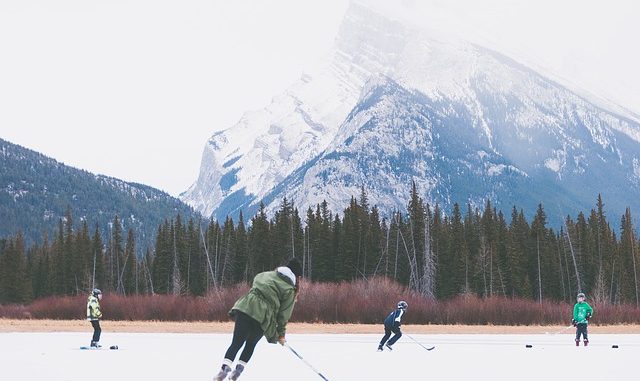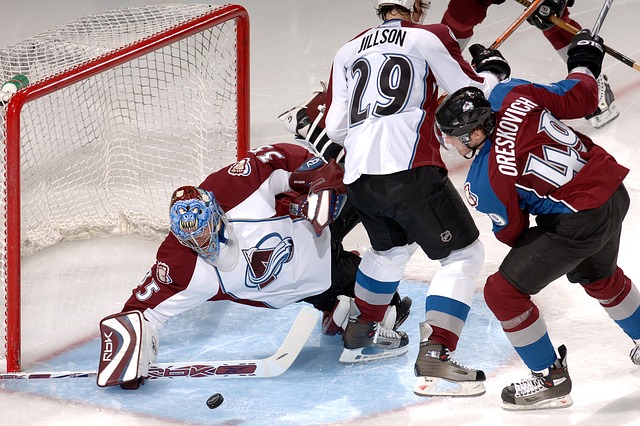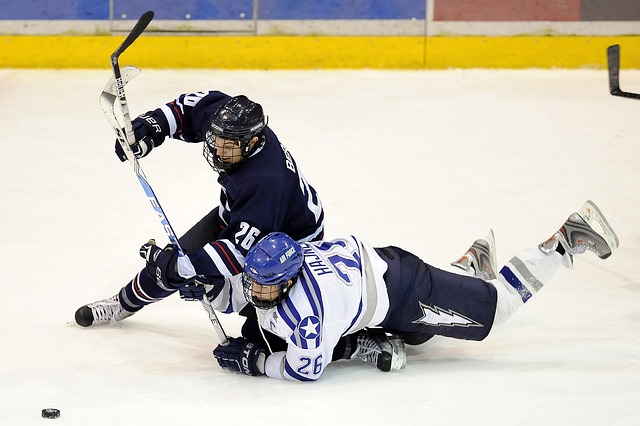
Justin Bieber and Michael Bublet are both huge fans of ice hockey, and can show you a few moves you’d be impressed with. But it’s not just pushing a hockey puck around an ice rink. It’s a bit more physical than that.
Unlike hockey, Ice hockey is a contact team sport. It can be rough, fast paced and a thrill to experience. Not surprisingly, ice hockey is played on ice. Two teams of ice skaters use their ice hockey sticks to shoot a rubber puck into their opponent’s net to score.
Ice hockey teams consist of six players, one of which is the goaltender. Due to the high velocity that the players can hit the ice hockey puck, the goaltender wears a huge amount of heavily padded protection including a face mask.
Ice hockey is most popular in the countries that reliably have snowy winters, namely Canada, central and eastern Europe, Scandinavia, and the United States.
Ice Hockey Rules
Between the six players on the ice, they are typically divided into three forwards, two defencemen, and a goaltender.
In addition to using their ice hockey sticks to hit the puck, within certain restrictions, players may redirect the puck with any part of their body. Players aren’t allowed to hold the puck in their hand and cannot use their hands to pass the it to their teammates unless they are in the defensive zone. Players are also prohibited from kicking the puck into the opponent’s goal, though intentional redirections off the skate are permitted. Players may not intentionally bat the puck into the net with their hands.
The boards surrounding the ice help keep the puck in play and they can also be used as tools to play the puck. Players are permitted to “bodycheck” opponents into the boards as a means of stopping progress. The referees, linesmen and the outsides of the goal are “in play” and do not cause a stoppage of the game when the puck or players are influenced (by either bouncing or colliding) into them.
Play can be stopped if the goal is knocked out of position. Play often proceeds for minutes without interruption. When play is stopped, it is restarted with a “faceoff”. Two players “face” each other and an official drops the puck to the ice, where the two players attempt to gain control of the puck. Markings on the ice indicate the locations for the faceoff and guide the positioning of players.
There are three major rules of play in ice hockey that limit the movement of the puck: “offside”, “icing”, and the puck going out of play. A player is “offside” if he enters his opponent’s zone before the puck itself. Under many situations, a player may not “ice the puck”, shoot the puck all the way across both the centre line and the opponent’s goal line. The puck goes “out of play” whenever it goes past the perimeter of the ice rink (onto the player benches, over the “glass,” or onto the protective netting above the glass) and a stoppage of play is called by the officials using whistles. It also does not matter if the puck comes back onto the ice surface from those areas as the puck is considered dead once it leaves the perimeter of the rink.
Ice Hockey Periods and Overtime

Professional ice hockey games consists of three “periods” of twenty minutes, the clock running only when the puck is in play. The teams change ends after each period of play, including overtime.
Recreational leagues and children’s leagues often play shorter games, generally with three shorter periods of play.
Various procedures are used if a tie occurs. In tournament play, as well as in the NHL playoffs, North Americans favour sudden death overtime, in which the teams continue to play twenty-minute periods until a goal is scored. Up until the 1999–2000 season regular season NHL games were settled with a single five-minute sudden death period with five players (plus a goalie) per side, with both teams awarded one point in the standings in the event of a tie. With a goal, the winning team would be awarded two points and the losing team none (just as if they had lost in regulation).
If the score remains tied after an extra overtime period, the subsequent shootout consists of three players from each team taking penalty shots. After these six total shots, the team with the most goals is awarded the victory. If the score is still tied, the shootout then proceeds to a sudden death format. Regardless of the number of goals scored during the shootout by either team, the final score recorded will award the winning team one more goal than the score at the end of regulation time. In the NHL if a game is decided in overtime or by a shootout the winning team is awarded two points in the standings and the losing team is awarded one point. Ties no longer occur in the NHL.
The overtime mode for the NHL playoffs differ from the regular season. In the playoffs there are no shootouts nor ties. If a game is tied after regulation an additional 20 minutes of 5 on 5 sudden death overtime will be added. In case of a tied game after the overtime, multiple 20-minute overtimes will be played until a team scores, which wins them the match.
Penalties

Altercations often occur near the goal after a stoppage of play, since defensive players are highly concerned with protecting their goaltender.
In ice hockey, infractions of the rules lead to play stoppages whereby the play is restarted at a face off. Some infractions result in the imposition of a penalty to a player or team. In the simplest case, the offending player is sent to the “penalty box” and their team has to play with one less player on the ice for a designated amount of time. Minor penalties last for two minutes, major penalties last for five minutes, and a double minor penalty is two consecutive penalties of two minutes duration. A single minor penalty may be extended by a further two minutes for causing visible injury to the victimized player. This is usually when blood is drawn during high sticking. Players may be also assessed personal extended penalties or game expulsions for misconduct in addition to the penalty or penalties their team must serve. The team that has been given a penalty is said to be playing “short-handed” while the opposing team is on a “power play.”
A two-minute minor penalty is often charged for lesser infractions such as “tripping”, “elbowing”, “roughing”, “high-sticking”, “delay of the game”, “too many players on the ice”, “boarding”, illegal equipment, “charging” (leaping into an opponent or body-checking him after taking more than two strides), “holding”, holding the stick (grabbing an opponent’s stick), “interference”, “hooking”, “slashing”, “kneeing”, “unsportsmanlike conduct” (arguing a penalty call with referee, extremely vulgar or inappropriate verbal comments), “butt-ending” (striking an opponent with the knob of the stick—a very rare penalty), “spearing”, or “cross-checking”. As of the 2005–2006 season, a minor penalty is also assessed for “diving”, where a player embellishes or simulates an offence. More egregious fouls may be penalized by a four-minute double-minor penalty, particularly those that injure the victimized player. These penalties end either when the time runs out or when the other team scores during the power play. In the case of a goal scored during the first two minutes of a double-minor, the penalty clock is set down to two minutes upon a score, effectively expiring the first minor penalty. Five-minute major penalties are called for especially violent instances of most minor infractions that result in intentional injury to an opponent, or when a “minor” penalty results in visible injury (such as bleeding), as well as for fighting. Major penalties are always served in full; they do not terminate on a goal scored by the other team. Major penalties assessed for fighting are typically offsetting, meaning neither team is short-handed and the players exit the penalty box upon a stoppage of play following the expiration of their respective penalties. The foul of “boarding” (defined as “check[ing] an opponent in such a manner that causes the opponent to be thrown violently in the boards”) is penalized either by a minor or major penalty at the discretion of the referee, based on the violent state of the hit. A minor or major penalty for boarding is often assessed when a player checks an opponent from behind and into the boards.
A “penalty shot” is awarded to a player when the illegal actions of another player stop a clear scoring opportunity, most commonly when the player is on a “breakaway”. A penalty shot allows the obstructed player to pick up the puck on the centre red-line and attempt to score on the goalie with no other players on the ice, to compensate for the earlier missed scoring opportunity. A penalty shot is also awarded for a defender other than the goaltender covering the puck in the goal crease, a goaltender intentionally displacing his own goal posts during a breakaway to avoid a goal, a defender intentionally displacing his own goal posts when there is less than two minutes to play in regulation time or at any point during overtime, or a player or coach intentionally throwing a stick or other object at the puck or the puck carrier and the throwing action disrupts a shot or pass play.
An ice hockey referee is responsible for assessing most penalties during a game.
Officials also stop play for puck movement violations, such as using one’s hands to pass the puck in the offensive end, but no players are penalized for these offences. The sole exceptions are deliberately falling on or gathering the puck to the body, carrying the puck in the hand, and shooting the puck out of play in one’s defensive zone (all penalized two minutes for delay of game).
In men’s hockey, but not in women’s, a player may use his hip or shoulder to hit another player if the player has the puck or is the last to have touched it. This use of the hip and shoulder is called “body checking.” Not all physical contact is legal—in particular, hits from behind, hits to the head and most types of forceful stick-on-body contact are illegal.
Ice Hockey Equipment
Ice Hockey Protective Equipment
Since men’s ice hockey is a full contact sport, body checks are allowed so injuries are a common occurrence. Protective equipment is mandatory and is enforced in all competitive situations. This includes a helmet (cage worn if certain age or clear plastic visor can be worn), shoulder pads, elbow pads, mouth guard, protective gloves, heavily padded shorts (also known as hockey pants) or a girdle, athletic cup (also known as a jock, for males; and jill, for females), shin pads, skates, and (optionally) a neck protector.
Goaltenders use more protective ice hockey equipment than other players, and use different equipment. With hockey pucks approaching them at speeds of up to 100 mph (160 km/h) they must wear equipment with more protection. Goaltenders wear specialized goalie skates (these skates are built more for movement side to side rather than forwards and backwards), a jock or jill, large leg pads (there are size restrictions in certain leagues), blocking glove, catching glove, a chest protector, a goalie mask, and a large jersey. Goaltenders’ equipment has continually become larger and larger, leading to fewer goals in each game and many official rule changes.
Ice Hockey Skates
Ice hockey skates are optimized for physical acceleration, speed and manoeuvrability. This includes rapid starts, stops, turns, and changes in skating direction. In addition, they must be rigid and tough to protect the skater’s feet from contact with other skaters, sticks, pucks, the boards, and the ice itself. Rigidity also improves the overall manoeuvrability of the ice hockey skate. Blade length, thickness (width), and curvature (rocker/radius (front to back) and radius of hollow (across the blade width) are quite different from speed or figure skates. Hockey players usually adjust these parameters based on their skill level, position, and body type. The blade width of most skates are about 1⁄8 inch (3.2 mm) thick.
Ice Hockey Sticks
The ice hockey stick consists of a long, relatively wide, and slightly curved flat blade, attached to a shaft. The curve itself has a big impact on its performance. A deep curve allows for lifting the puck easier while a shallow curve allows for easier backhand shots. The flex of the stick also impacts the performance. Typically, a less flexible stick is meant for a stronger player since the player is looking for the right balanced flex that allows the stick to flex easily while still having a strong “whip-back” which sends the puck flying at high speeds. It is quite distinct from sticks in other sports games and most suited to hitting and controlling the flat puck. Its unique shape contributed to the early development of the game.
Where can I Play Ice Hockey
In the UK, ice hockey is played at indoor ice skating rinks. Due to the cold icy winters in Canada and Scandinavia, informal ice hockey games are sometimes held on frozen ponds and lakes.
If you like the idea of playing ice hockey, you should try skating at one of the Christmas ice rinks first to see whether you can skate or not.
